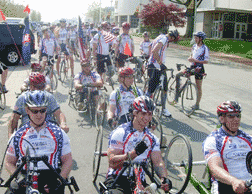|
|||||||||
The Road HomeWounded Warriors conquer Annapolis On the south lawn of the White House, on a gloriously sunny spring day, as President George W. Bush shook the hands of 25 brave vets on bicycles who had lost various limbs in Iraq, I began to cry. I had been invited to be a part of the Wounded Warrior Project, and this gathering in our nation’s capital was the kickoff for the White House to Lighthouse Soldier Ride. In Annapolis, that’s Thomas Point Lighthouse. Out of the blue, Woody Groton, the group’s executive director, asked me to put together a challenging ride around town that would include a glimpse of the lighthouse. I met the riders and their support crew at Jonas Green Park, after they finished a long ride from the Inner Harbor in Baltimore to Annapolis via the B&A Trail. My old friend Dave Dionne, who is in charge of county trails, had led them. He introduced me to Woody. Woody put this crazy dream together to rehabilitate wounded vets in both mind and body, to challenge them to seize their lives, to become something more than they ever were or thought they ever could be. Volunteers from New York to Florida accompanied the riders on their quest, with aid from sponsors like U-Haul, providing the trucks to haul all the gear, and Trek, providing the tricked-out bikes for each rider. Embraced as part of the Wounded Warrior family, soon, I was driving their giant U-Haul filled with all of the bikes and gear back to my house where it could be parked safely for the night. I hadn’t known these folks for an hour, and they trusted me with everything they owned. Semper Fi, baby. I had laid out a route that included virtually every major road in Annapolis: the Naval Academy Bridge, Main Street, Rowe Boulevard, Taylor Avenue, Spa Road, Hilltop Lane, Bay Ridge Avenue and the Eastport Bridge. The ride included stops at City Dock for a warm welcome from city and state officials, Navy-Marine Corps Memorial Stadium, the Annapolis Police Station, Maryland Hall for the Creative Arts, the Chesapeake Children’s Museum, and the Bay Ridge Community Pool before finishing back at City Dock at Armadillos. Words seem puny to describe our ride. All I remember are images of great sadness, joy and triumph. A dark-haired lady vet holding her carbon fiber leg behind her back before the ride, as she flirted with the boys. A wounded young officer with only one leg and one arm, tenderly kissing his wife for almost a minute right before they began the grueling 25-mile ride. Trying my best to stay out in front of three legless low-riders who raced one another the whole way, talking steadily about training for the Olympics together. Two soldiers who had lost both of their legs, now rolling like wet Labs in the cool grass under a giant oak at our lunch stop at Maryland Hall. The volunteers from American Legion Post 175 and Salute our Veterans passing out lunches and whispering words of encouragement to each of the hot and tired riders, as if they were their sons and daughters. A veteran getting out of his car in the middle of the street to shake hands and thank riders when we stopped to fix a bike on Hilltop Lane. The families who lined the route in Bay Ridge, waving homemade signs and flags. Naval Academy graduate Andrew Kinnard, who lost both legs, encouraging the members of the Academy Cycling Team to be all they can be. A soldier who had been in a coma for four months and who the doctors all thought should be dead, riding a tricycle around town as Parker Jones of Capital Cycle pushed him up each hill. And the after-ride party at Armadillos, where Brendan the owner supplied not only free beer but foxy Miller Lite girls to serve it to the thirsty and triumphant soldiers. The Wounded Riders represent both loss and inspiration. They come from towns large and small, from luxury and poverty. They each have a story to tell. But they are not superheroes. Some are bitter, and some are better. They are us. When we look at them we see ourselves and wonder: Could I rise above such wounds? And so, the healing begins. |
|||||||||
|
|||||||||
|
|
|||||||||
|
© COPYRIGHT 2008 by New Bay Enterprises, Inc. All rights reserved. |
|||||||||
 Volume 16, Issue 18 - May 1 - May 7, 2008
Volume 16, Issue 18 - May 1 - May 7, 2008
